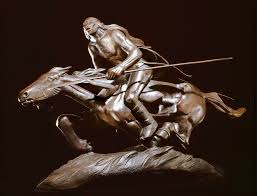Allan Haozous, popularly known as Alan Hauser, has been an amazing artist with deep Apache roots. Born in 1914 in Apache, Oklahoma, Alan grew up surrounded by the memories, traditions, and records of his people. In years he has become one of the most celebrated Native American artists, with Apache statues commemorating his conscience, objects and favorite images
Incremental Apache
Allan Haozous relationship with the lifestyle began at home. His father, Sam Haojous, had lived through very difficult times in Apache affairs, being the last of the Chiricahua Apaches to be released from slavery to the US. one of the most lucrative government
As a young boy in Oklahoma City, he comes to be surrounded by the rich tradition of the Apache Machine. This first impression sparked his love of painting and storytelling, and most importantly, he could invent ways to make his lifestyle unique with glory and strength
Finding her artistic voice
Allan Haozous journey as an artist began when he attended the Santa Fe Indian School in the nineteen-thirties. Here he studied under Dorothy Dunn, who discovered his talent and helped develop his talent for drawing and painting. This is ultimately where Alan first began to blend traditional Apache crisis themes with current design approaches, enhancing a style that uniquely comes across as informal.
At 1949, Alan was given the risk of looking at sculpture at the newly opened Institute of American Indian Art in Santa Fe, New Mexico This ended up being a turning point in his career. Form allowed him to present his vision of lifestyle in 3 dimensions, and he quickly discovered contemporary designs His art often features clean, flowing lines and effective forms,
Breaking barriers to recognition
The artwork is definitely not by Allan Haozous; He made the words. Alan’s art received national attention at the same time that Native American artists often went unnoticed. He became one of the first Native American artists to be diagnosed in mainstream film circles, which rightly turned into a big story.
To remain true to his Apache roots
Despite achieving his fulfillment and recognition internationally in a wide range of art forms, Alan does not stray one bit from his Apache roots by any means. Her art has been greatly inspired by the traditions, memories and spiritual beliefs of her people. Many of his sculptures depicted characters from Apache folklore, warriors, and routines from Apache life. Through his self-portraits, Alan sought to capture the essence of his lifestyle and be 100 percent in tune with the stage
Preserving Apache culture through the arts
Allan Haozous realized that his art is among the best current auctions; emerges as a way to maintain the Apache way of life for future generations. At a time when many Native American traditions were easily forgotten, Alan’s paintings helped keep those traditions alive. His sculpture and artwork knows stories that have been passed down through generations, ensuring they are shared and remembered.
Respect and Lasting Impact
In life, llan Haozouss has received numerous honors for his contributions to the international visual arts scene. In 1992, he was honored with the National Medal of Art, a very prestigious honor for artists within the United States. This award did not mark his skill as the best but in addition the impact of his art on the advancement of Native American art.
Haojous Properties
Allan Haozous died in 1994, but his legacy lives on through his photographs and his personal family. His sons Philip and Bob Haozous followed in their father’s footsteps and became accomplished artists in their own right. They are retained to learn problematic issues of identity, lifestyle, and self-image issues, having a functional lifestyle that Alan has already begun.
Conclusions
Allan Haozous comes to be more than just an artist he is a storyteller, a cultural ambassador, and a bridge between the distant and the present. Through his photographs, he brought Apache memories to life, ensuring that their voices would not be forgotten His photographs continue to inspire and be part of people today, reminding us of the power of photographs to hold and give us culture muscles survive . Alan’s legacy is a testament to his lasting electrical glory
